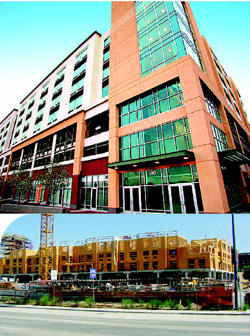As a result, more cities are seeing redevelopment agencies either sprout up or assert themselves as public partners that support private infill housing development with tax incentives for buyers and builders, density bonuses, attractive land prices and financing, and zoning variances.
No developer, however, would invest in brownfields or even a scattered-lot project without demand. Population growth is a big indicator, but so is a shifting demographic of urban dweller. Young professional singles and childless couples have – typically been attracted to city life, but aging baby boomers? Apparently so. “They’re looking for new homes that are near the downtown action, convenient and walkable,” says Tombari. “It’s a different kind of retiree than 20 years ago.”
A Different House New types of buyers demand different types of homes, as well. While the romantic notion of a warehouse adapted into residential lofts still appeals to a certain segment of (mostly young) urban buyers and renters, the ticket for retirees are new, relatively small, well-appointed, and low-maintenance detached homes or townhouses. “It’s a higher-end home,” says Haughey, regarding the new urban nest. “The emphasis is on finishes, convenience, and security.”
Bissette’s homes in Springfield, for instance, are in the 2,300-square-foot range; more important, they follow the architectural character of the neighborhood’s existing homes—a critical consideration to sustaining political and social support for (and profits from) infill housing.
“If the [new] homes don’t match the character of the older ones, they will have a shorter life span,” says Turner, who while mayor of Dayton, Ohio, formed coalitions among lenders, city leaders, and builders to foster infill development. “Builders saw that [matching the character of the existing homes] would help sales and resales and enhance the neighborhood.”
In addition to helping to pre-sell half of his first phase of 22 homes, Bissette also says staying in character encourages gentrification. “You put one or two new homes on a block and it inspires others to invest in renovating their homes,” he says. “They take charge of their homes because they believe they can increase in value,” which, in turn, spurs other aspects of the local economy in terms on tax revenue, investment, services, and jobs. Builders who stray out of character, however, often feel the wrath of neighbors and local officials who resent—and politically oppose—infill development.
Single-family detached homes, however, remain the exception rather than the rule for infill housing. While ULI’s Haughey points to Southern cities as the most likely to have significant inventories of vacant lots for detached homes (such as what Bissette found in Jacksonville and Atlanta, where he builds similar infill projects), the majority of the opportunity remains in attached single-family and multifamily projects.
Even so, cities are seeing and encouraging variations on the high-rise condo, with mid-rise, mixed-use, and/or row-house development that combines high density with high style and convenience.
In Boise, Idaho, for instance, well-scaled infill multifamily buildings have succeeded while an urban tower project failed. “The trend now is a six- to eight-story building topped out with residential,” says Torry McAlvain, president of McAlvain Construction in Boise. The company’s Civic Plaza Apartments project, completed earlier this year, features three stories of 130 rental apartments above two levels of parking and street-level retail—and is currently 95 percent leased.
Opportunities and Challenges The trend away from high-rise buildings to more moderate mid- and low-rise projects, as well as single-family construction, gives hope to dealers looking to wedge their way into the city without necessarily adding different breeds of builders to their client lists or new product categories to their inventories.



